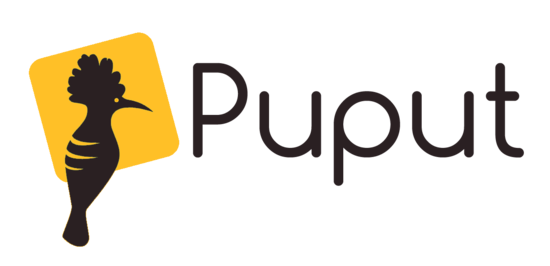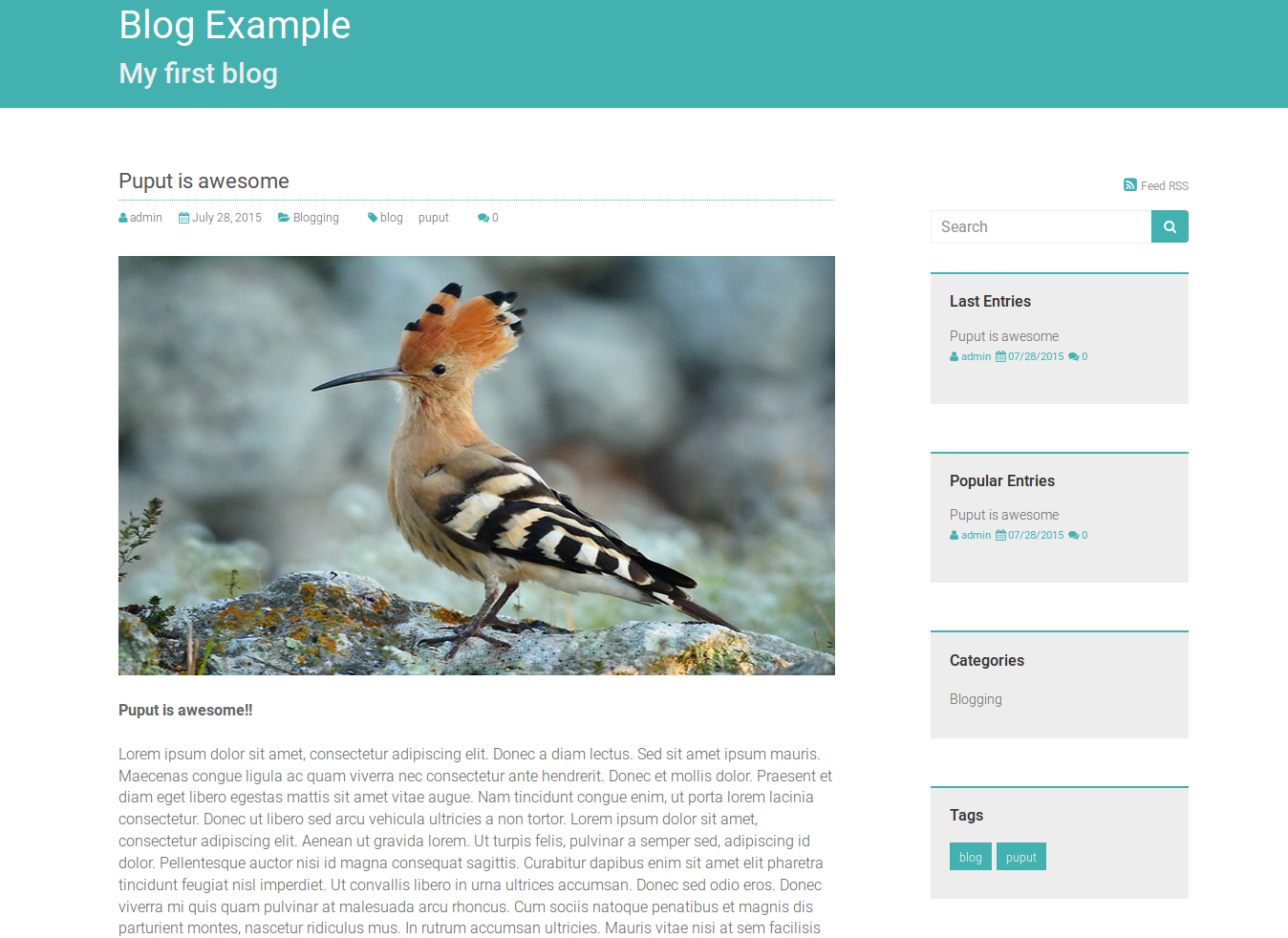A Django blog app implemented in Wagtail.
Project description

Puput
Puput is a powerful and simple Django app to manage a blog. It uses the awesome Wagtail CMS as content management system.
Puput is the catalan name for Hoopoe which is indeed a beautiful bird.

Features
Built with Wagtail CMS and Django
Inspired in Wordpress and Zinnia
Simple & responsive HTML template by default
SEO friendly urls
Support for Disqus comments
Entries by author, tags, categories, archives and search term
Last & popular entries
Configurable sidebar widgets
RSS feeds
Related entries
Extensible entry model

Setup
If you have a running Django project and you want to add blog site to your project, please follow Standalone blog app steps. Otherwise follow the Wagtail blog app steps if you are currently using Wagtail on your project.
Standalone blog app
Install Puput and its dependencies
pip install puputAdd
PUPUT_APPSto yourINSTALLED_APPSinsettings.pyfile.
from puput import PUPUT_APPS
INSTALLED_APPS += PUPUT_APPSThis includes Puput, Wagtail apps and Third party apps.
If you have on of these apps previously defined in your INSTALLED_APPS please include manually this apps in order to avoid apps collisions:
INSTALLED_APPS = (
...
'wagtail.wagtailcore',
'wagtail.wagtailadmin',
'wagtail.wagtaildocs',
'wagtail.wagtailsnippets',
'wagtail.wagtailusers',
'wagtail.wagtailimages',
'wagtail.wagtailembeds',
'wagtail.wagtailsearch',
'wagtail.wagtailsites',
'wagtail.wagtailredirects',
'wagtail.wagtailforms',
'wagtail.contrib.wagtailsitemaps',
'wagtail.contrib.wagtailroutablepage',
'compressor',
'taggit',
'modelcluster',
'puput',
)Add Wagtail required middleware classes in
settings.pyfile
MIDDLEWARE_CLASSES = (
...
'wagtail.wagtailcore.middleware.SiteMiddleware',
'wagtail.wagtailredirects.middleware.RedirectMiddleware',
)Add
requestcontext processor toTEMPLATE_CONTEXT_PROCESSORSstructure insettings.pyfile
TEMPLATE_CONTEXT_PROCESSORS = (
...
'django.core.context_processors.request',
)Set
WAGTAIL_SITE_NAMEvariable insettings.pyfile with your site name:
WAGTAIL_SITE_NAME = 'Puput blog'Set
MEDIA_ROOTandMEDIA_URLvariable insettings.pyas described in the Wagtail Docs:
MEDIA_ROOT = os.path.join(PROJECT_ROOT, 'media')
MEDIA_URL = '/media/'Place Puput urls at the bottom of the urlpatterns. It also includes Wagtail urls:
urlpatterns = [
...
url(r'', include('puput.urls')),
]To make your Django project serve your media files (ex: uploaded contents) during development, don’t forget to add this to your urlpatterns:
from django.conf import settings
if settings.DEBUG:
import os
from django.conf.urls import patterns
from django.conf.urls.static import static
from django.views.generic.base import RedirectView
from django.contrib.staticfiles.urls import staticfiles_urlpatterns
urlpatterns += staticfiles_urlpatterns() # tell gunicorn where static files are in dev mode
urlpatterns += static(settings.MEDIA_URL + 'images/', document_root=os.path.join(settings.MEDIA_ROOT, 'images'))
urlpatterns += patterns('',
(r'^favicon\.ico$', RedirectView.as_view(url=settings.STATIC_URL + 'myapp/images/favicon.ico'))
)Run
python manage.py migrateandpython manage.py puput_initial_datato load initial data to start a blog site.Open your broswer at http://127.0.0.1:8000/blog/ to view your blog home page. Go to http://127.0.0.1:8000/blog_admin/ to view the admin site and edit your content.
Wagtail blog app
Install Puput and its dependencies
pip install puputAdd
puput,wagtail.contrib.wagtailsitemapsandwagtail.contrib.wagtailroutablepageto yourINSTALLED_APPSinsettings.pyfile.If you have previously defined Wagtail urls in
urls.pysetPUPUT_AS_PLUGIN = Truein thesettings.py. This will avoid to include Wagtail urls again when you include necessary Puput urls.Include Puput urls in
urls.pybefore Wagtail urls.
urlpatterns = [
...
url(r'', include('puput.urls')),
url(r'', include(wagtail_urls)),
]Run
python manage.py migrate
Docker
If you want to run Puput in a Docker container please visit docker-puput for detailed instructions.
Documentation
Visit Puput documentation for the detailed documentation.
Project details
Release history Release notifications | RSS feed
Download files
Download the file for your platform. If you're not sure which to choose, learn more about installing packages.












